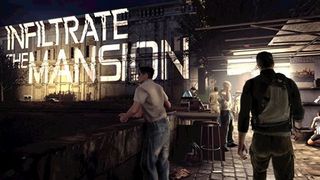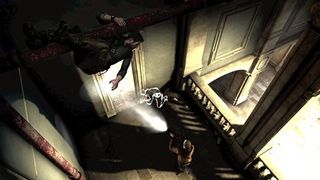Ubisoft had never intended for anyone to play Conviction’s E3 demo, so it’s easy for us to completely break it within about four minutes of starting the game. We’re standing in a room, surrounded by armed men emptying round after round into Sam while he clutches bad guy Kobin by the throat and soaks up bullets like Robocop – while a forced cut-scene makes him invincible. Let’s try that again.

The Splinter Cell we’re playing isn’t the one we saw in 2007 – Tramp Fisher, strolling around in broad daylight, finding cover in plain sight, and using crowds to hide. It’s from the ashes of that project the new Conviction has risen – still running on that heavily modified Unreal Engine 2, and still using a few of the same physics tricks, but with everything else thrown out and a new game built on the remains.
“We presented the game at Ubidays in May of 2007,” says Ubisoft’s Andréane Meunier. “We listened to a lot of criticism we were getting and we found that we had strayed away from the core Splinter Cell values, so people didn’t recognize Splinter Cell anymore. We went back to our core values, which are the stealth and the gadgets and everything that people know and love about Splinter Cell. It’s Ubisoft saying ‘let’s give this another go; let’s not release something that people don’t like’.”
The tiny level demonstrated at E3 is a mash-up of the game’s first two levels. It begins in a public toilet where Sam interrogates one of Kobin’s thugs, moves on to the streets surrounding Kobin’s mansion, proceeds into the mansion and climaxes with a raid on Kobin’s office. Kobin, an arms dealer, drove the car which killed Sam’s daughter but since arms dealers don’t often carry out random hits on random girls just for the laughs, Sam has bigger fish to fry. He’s there to interrogate, not kill the man.

It was a demo built to be played just one way, in live hands-off demos. The world has already seen the demo played to perfection, so we looked for new ways to mess with Ubisoft’s miniature sandbox and went out of our way to play the game as ‘wrong’ as we possibly could. Instead of dragging the mansion’s guard over a wall, we walked straight at the frigger. A white ring appeared in the center of the screen and began rapidly shrinking; in public or in shadow the ring is Sam’s new stealth meter – a brief warning when an enemy agent clocks you. It’s fast, deliberate, and is accompanied by a sharp audio spike – an unmistakable ‘run away quickly!’ alarm.
Back in 2007 the former Project lead Dany LePage told us Splinter Cell: Chaos Theory had taken shadow stealth as far as it could possibly go; that they “went through every possible situation with that mechanic,” but Conviction has found space to explore new territory in the shadows. “We’ve tried other things and maybe we’ve proved him wrong a little bit,” says Andréane. “We didn’t really try to redefine the light and shadow in itself, but more the way that it’s presented to the player.”

“Our creative director felt that waiting was not empowering. People would tell me you can stay in the shadows, leave your console and come back later and you still won’t get detected (in Chaos Theory). What he wanted was to feel like a predator; like a panther. He wanted what he called Active Stealth. You’re stealthy not because you’re hiding, but because you’re hunting and you’re about to do something awesome.”
